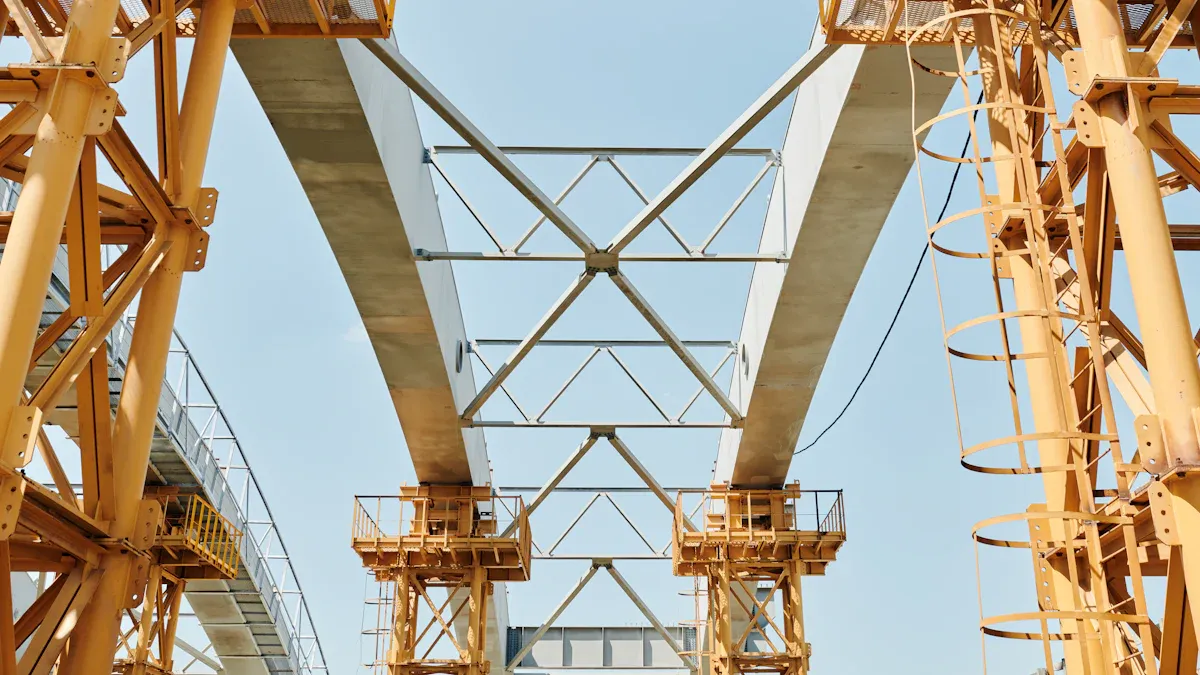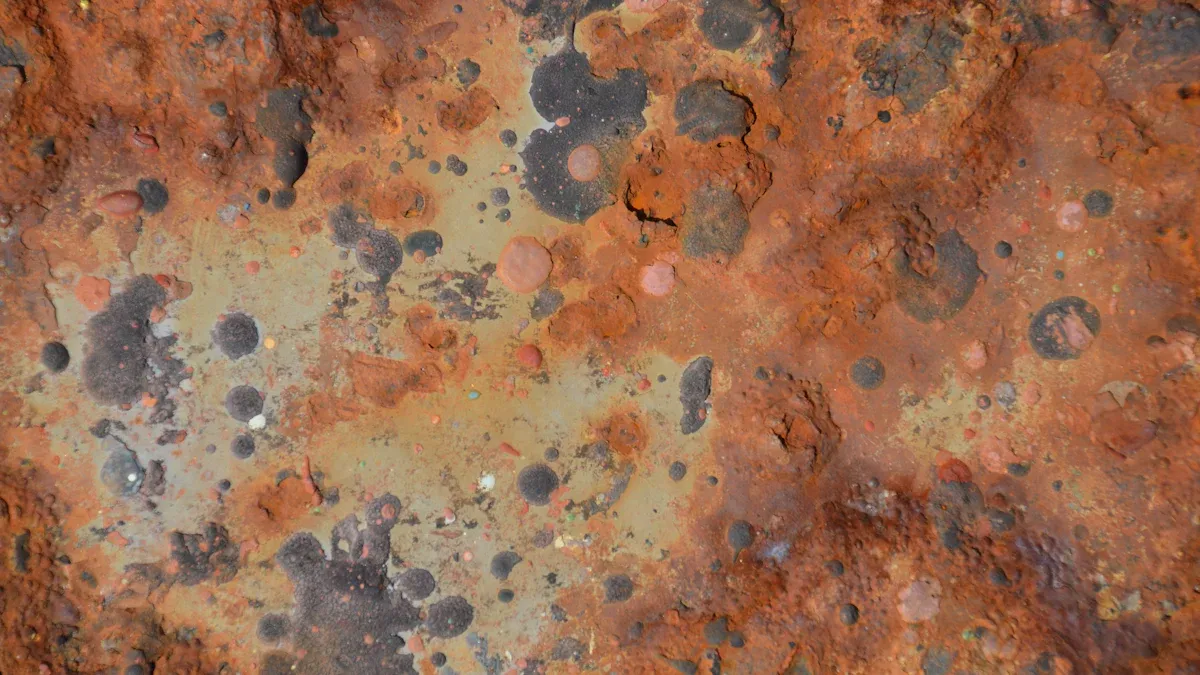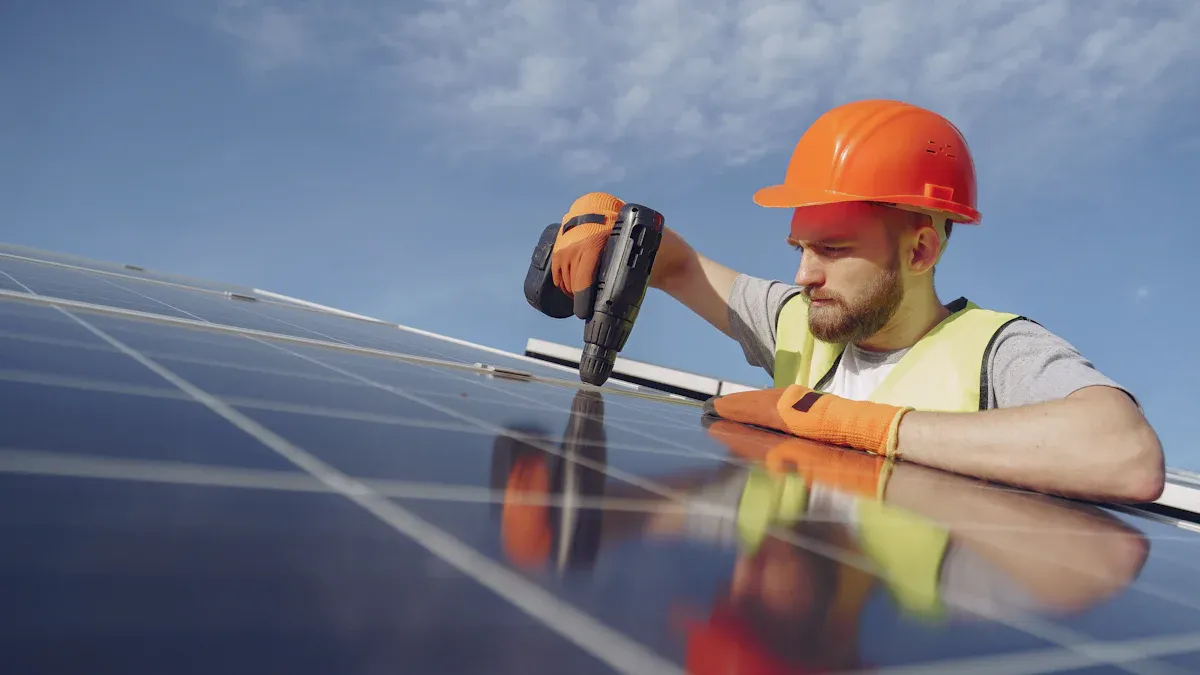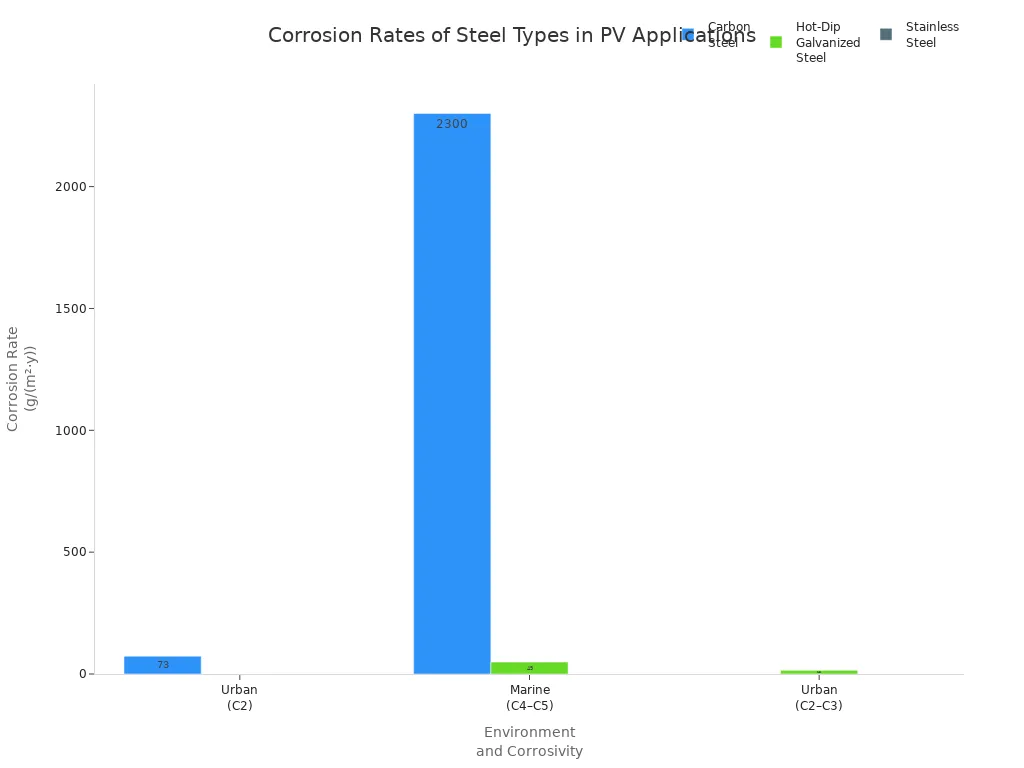Corrosion Rate and Protective Design Safety Thresholds for Steel Structure for PV Panel

Steel Structure for PV Panel installations face significant corrosion risks, especially in harsh environments such as coastal or polluted areas. Atmospheric and soil conditions can cause rapid degradation, with some galvanized steel piles experiencing severe corrosion in as little as five years. Material selection plays a critical role in long-term durability. Hot-dip galvanized steel remains a popular choice due to its zinc coating, which acts as a sacrificial barrier and offers enhanced protection, particularly in alkaline or concrete-contact environments. Alternatives like Galvalume and PosMAC provide even greater resistance in aggressive settings, though at higher costs. No universal standards exist, so best practices in design and maintenance remain essential for reliable performance.
Key Takeaways
Steel structures for PV panels face corrosion risks from environment and soil, which can weaken supports and cause costly failures.
Choosing corrosion-resistant materials like hot-dip galvanized or stainless steel greatly extends the lifespan of PV panel supports.
Protective coatings and proper steel thickness tailored to site conditions help prevent corrosion and maintain structural safety.
Regular inspections and maintenance catch early corrosion signs, reducing repair costs and ensuring long-term durability.
Design details like good drainage, joint protection, and monitoring technologies improve corrosion resistance and system reliability.
Corrosion Risks

Structural Impact
Steel structures supporting PV panels face a range of corrosion threats that directly affect their strength and stability. In humid regions, moisture promotes electrochemical and galvanic corrosion, especially at joints and fasteners. Coastal and industrial environments introduce salt and pollutants, which accelerate pitting corrosion and can cause protective coatings to fail. Desert sites expose steel to intense UV radiation and thermal cycling, leading to coating breakdown and mechanical fatigue.
Regular inspections help detect early signs of corrosion, which is critical for maintaining the load-bearing capacity of PV mounting systems.
Corrosion often appears as rust, material fatigue, or weathering on metal components. Over time, this degrades both the protective coating and the steel itself, reducing the effective thickness and strength of the structure. When corrosion progresses unchecked, it compromises the structural integrity of PV panel supports, increasing the risk of mechanical failure. Soil conditions, such as low resistivity or high water tables, can further accelerate corrosion at ground-contact points.
The table below summarizes common corrosion types and their impact on steel structures:
Corrosion Type | Description | Typical Environment | Impact on Structure |
|---|---|---|---|
Uniform Corrosion | Even metal loss across surfaces | Rural, low humidity | Gradual weakening |
Pitting Corrosion | Localized deep pits | Coastal, marine | Rapid, localized failure |
Crevice Corrosion | In joints and fasteners | All, especially humid | Hidden, severe weakening |
Galvanic Corrosion | Between dissimilar metals | Moist, mixed-metal systems | Accelerated loss at connections |
Financial Implications
Corrosion in steel PV structures leads to significant financial consequences. When corrosion reduces the strength of mounting systems, operators may face costly repairs or even full replacement of affected components. In high-risk environments, severe corrosion can occur within five years, far short of the expected 25-year service life for most PV installations.
Unplanned maintenance and downtime disrupt energy production, resulting in lost revenue. The need for specialized materials, such as stainless steel or advanced coatings, increases initial project costs but helps avoid larger expenses later. Regular inspections and professional assessments, while adding to operational budgets, extend the lifespan of steel structures and protect long-term investments.
Investing in corrosion-resistant materials and proactive maintenance reduces the risk of structural failure and minimizes unexpected financial losses.
By understanding the specific corrosion risks at each site, project teams can select appropriate mitigation strategies and ensure the financial sustainability of PV panel systems.
Corrosion Rate Factors
Environment
Environmental conditions play a decisive role in the corrosion rate of steel structures supporting PV panels. Several factors influence how quickly corrosion develops:
Chloride deposition, especially in marine or coastal areas, accelerates corrosion by breaking down protective layers.
Precipitation and relative humidity increase the time surfaces remain wet, promoting electrochemical reactions.
Temperature extremes, both high and low, affect the rate of corrosion and the durability of protective coatings.
SO₂ deposition from industrial pollution can create acidic conditions, further increasing corrosion risk.
Solar radiation and the length of exposure period also impact the breakdown of coatings and rust formation.
Salt-laden air, especially near the ocean, introduces aggressive ions that attack steel surfaces.
Neglected maintenance allows contaminants to accumulate, worsening corrosion over time.
Regular monitoring of these environmental factors helps engineers predict corrosion rates and select appropriate protection strategies.
Soil Conditions
Soil characteristics directly affect the corrosion of steel foundations for PV panel structures. Key factors include:
Soil moisture and chloride content create conductive environments that speed up corrosion.
Acidic soils (pH below 5) increase corrosion rates, while neutral soils (pH around 7) minimize risk.
Well-aerated soils, such as sandy or yellow/brown/red soils, tend to be less corrosive.
Poorly aerated soils, like gray soils, retain moisture and promote corrosion.
Sulfate ions, while less aggressive than chlorides, can transform into highly corrosive sulfides through microbial activity.
Microbial activity, especially from sulfate-reducing bacteria, produces corrosive byproducts.
Temperature variations and soil texture influence evaporation and moisture retention, affecting corrosion behavior.
Engineers often use coatings, sacrificial anodes, or impressed current systems to protect steel piles in challenging soil conditions.
Material Choice
Material selection determines the inherent corrosion resistance of PV support structures. The table below compares common materials:
Material Type | Corrosion Resistance Characteristics |
|---|---|
Carbon Steel | Prone to rust; requires protective coatings for durability. |
Excellent resistance due to zinc coating acting as a sacrificial barrier. | |
Stainless Steel | Superior resistance; chromium content forms a passive oxide layer, preventing rust and oxidation. |
Stainless steel offers the highest durability and lowest maintenance needs, making it ideal for harsh environments. Hot-dip galvanized steel provides a balance of cost and protection, suitable for most outdoor PV applications. Carbon steel, while strong, needs robust coatings to prevent rapid degradation. Material choice should always reflect site-specific environmental and soil conditions for optimal performance.
Steel Structure for PV Panel: Corrosion Rates

Field Data
Corrosion rates for steel structures in PV panel applications depend on material type and exposure conditions. Industry literature and field studies provide valuable benchmarks for expected performance.
Steel Type | Typical Corrosion Rate Range | Corrosivity Categories (ISO 9223) | Notes |
|---|---|---|---|
Carbon Steel (CS) | Up to a few hundred µm/year | Urban: C2 (10–200 g/(m²·y)) | Corrosion rate varies with environment; rust layer is mildly protective and non-adherent. |
(e.g., ~73 g/(m²·y) mean in urban) | Marine: C4 to C5 (200–2300 g/(m²·y)) | Higher rates in marine environments due to chloride deposition and wetness. | |
Hot-Dip Galvanized Steel (GS) | 0.1–0.7 µm/year in low corrosivity (C1) | Urban: C2 to C3 (0.7–15 g/(m²·y)) | Zinc coating thickness up to 100 µm; corrosion rates 10–30 times lower than carbon steel. |
4.2–8.4 µm/year in high corrosivity (C5) | Marine: C4 to C5 (up to ~49 g/(m²·y)) | Zinc corrodes sacrificially, forming protective Zn-carbonate layers in urban atmospheres. | |
Stainless Steel (SS) | Pit growth limited to tenths of µm/year | N/A | General corrosion very low; localized corrosion possible but mostly aesthetic staining. |

Hot-dip galvanized steel demonstrates corrosion rates three to six times lower than bare carbon steel in buried environments. Pitting corrosion rates for galvanized steel are four to twenty times lower than those for bare steel. Field data show that galvanized coatings remain durable even under extreme temperatures, ranging from -40°F to 392°F. In sandy, coarse soils with low moisture, the service life of hot-dip galvanized steel often exceeds 75 years. Stainless steel exhibits the lowest corrosion rates, with pit growth limited to tenths of a micron per year. Carbon steel, by contrast, can corrode rapidly, especially in marine or polluted urban environments.
Many solar projects use hot-dip galvanized steel for PV panel supports in desert and coastal climates. These installations often achieve maintenance-free operation for 25 to 50 years, aligning with the design life of most solar infrastructure. Bare steel, even in low-corrosivity soils, remains vulnerable to airborne pollutants and moisture, which can initiate corrosion.
Field studies highlight the importance of material selection and protective coatings for achieving long-term durability in steel structure for PV panel installations.
Environmental Variations
Environmental and soil conditions create significant variability in corrosion rates for steel structure for PV panel systems. Real-world data and case studies reveal several key factors:
Corrosion rates in soils depend on moisture content, soil type, and permeability. Fine sandy soils tend to cause less corrosion, while stiff, lumpy clays with large voids promote severe localized corrosion.
Soil environments vary in composition and compaction, directly influencing the corrosion of buried steel. Oxygen availability and water-holding capacity in soil void spaces play a critical role in initiating corrosion.
Experimental studies show that burial depth, soil characterization, and moisture exposure all affect corrosion outcomes. Surface area contact with soil, such as in circular bars versus sheet piles, changes the exposure and risk.
Protective design strategies, including corrosion allowance and coatings, must consider the specific corrosivity of the soil. Soil compaction quality and the presence of air gaps around steel components alter oxygen and moisture access, impacting corrosion rates.
Case studies from infrastructure projects, such as mechanically stabilized earth walls and piles, illustrate the wide range of corrosion behaviors in different soil types.
Climate also influences corrosion rates. In coastal U.S. regions, rising temperatures and humidity due to climate change are projected to increase corrosion rates for steel infrastructure. Under high-emission scenarios, the useful life of steel structures may decrease by 8-16%. Even moderate scenarios predict a 3-7% reduction by the end of the century. These changes could lead to significant economic losses, especially for large-scale installations.
Engineers must assess both environmental and soil conditions when designing steel structure for PV panel systems to ensure reliable, long-term performance.
Design Thresholds
Codes and Guidelines
No universal standard governs corrosion protection for steel structures in PV panel systems. Industry professionals rely on a combination of regional codes, manufacturer recommendations, and proven best practices. Most projects reference guidelines from organizations such as the American Institute of Steel Construction (AISC), ASTM International, and ISO standards. These documents provide general requirements for material quality, coating application, and structural safety.
Industry best practices address the lack of universal standards by tailoring solutions to specific site conditions. Engineers often select hot-dip galvanized steel with coating thicknesses adjusted for environmental severity. For example, a standard zinc coating of 55–80 μm suits moderate climates, while 100 μm or more is recommended for coastal or industrial zones. Regular maintenance schedules, especially in aggressive environments, help extend the lifespan of steel structures. Material selection considers both environmental exposure and mechanical load requirements. Aluminum, with its natural oxide layer, sometimes replaces steel in highly corrosive settings. Surface treatments and advanced technologies further enhance durability.
Engineers should always consult local codes and engage registered design professionals to validate structural safety and corrosion protection strategies.
Minimum Thickness
The minimum thickness of steel and protective coatings plays a critical role in the durability of PV panel support systems. Codes and guidelines typically specify minimum steel thicknesses based on structural loads and environmental exposure. For hot-dip galvanized steel, the zinc layer must meet or exceed the minimum required by ASTM A123 or ISO 1461. In moderate environments, a zinc coating of 55–80 μm is common. In harsher climates, such as coastal or industrial areas, engineers increase the coating thickness to 100 μm or more.
The table below summarizes typical minimum thickness recommendations:
Environment | Steel Thickness (mm) | Zinc Coating (μm) |
|---|---|---|
Rural/Urban | ≥ 2.5 | 55–80 |
Coastal/Industrial | ≥ 3.0 | 100+ |
Stainless steel components, while more expensive, require less concern for coating thickness due to their inherent corrosion resistance. Fasteners and attachment points often use stainless steel or receive additional protective caps to prevent localized corrosion.
Proper selection of steel thickness and coating ensures the structure can withstand both mechanical loads and environmental degradation over its intended lifespan.
Service Life
The service life expectation for a Steel Structure for PV Panel system aligns with the lifespan of the PV installation itself. Most solar projects design their steel structures for a minimum of 25 years, matching the typical warranty period for PV modules. After this period, the salvage value of the structure is usually negligible, so the initial design must ensure durability throughout the entire service life.
Key recommendations for achieving the desired service life include:
Use corrosion-resistant metals such as stainless steel, aluminum alloys, or brass alloys for structural and attachment components.
Specify stainless steel fasteners or protective caps for elements exposed to the weather.
Engineer mounting systems to withstand local wind, snow, and seismic loads, with validation by a registered design professional.
Require attachment components to pass water penetration and holding capacity tests, following standards like ASTM E 2140 and ISO 17025.
Perform regular inspections and maintenance, especially in high-risk environments.
Testing and engineering validation ensure that the Steel Structure for PV Panel meets both safety and durability requirements. While explicit numerical safety factors may not always appear in guidelines, most designs incorporate conservative assumptions to account for uncertainties in environmental exposure and material performance.
A well-designed steel structure, built with appropriate materials and coatings, can reliably support PV panels for 25 years or more, even in challenging environments.
Protection Strategies
Coatings
Protective coatings form the first line of defense against corrosion for steel structures. Engineers often select zinc-rich paints, epoxy coatings, or specialized primers to shield steel from moisture and environmental stress. In areas with high humidity or salt exposure, marine-grade coatings and UV-resistant paints help maintain structural integrity. These coatings act as barriers, preventing oxygen and water from reaching the steel surface. Regular inspection and timely reapplication of coatings ensure ongoing protection, especially in harsh climates.
Tip: UV-resistant and heat-resistant coatings extend the lifespan of steel supports exposed to intense sunlight and temperature fluctuations.
Galvanizing
Hot-dip galvanizing stands out as the most effective and economical method for protecting steel in PV panel systems. This process immerses fully fabricated steel components in molten zinc, creating a thick, uniform coating. The zinc layer acts as a sacrificial barrier, absorbing corrosion and preserving the underlying steel. Hot-dip galvanized steel offers maintenance-free service for 25 to 50 years, even in coastal or industrial environments. Compared to electro-galvanizing, hot-dip galvanizing provides a thicker coating and superior durability.
Protection Method | Typical Zinc Thickness (µm) | Service Life (years) | Maintenance Needs |
|---|---|---|---|
Hot-Dip Galvanizing | 35–99 | 25–50+ | Minimal |
Electro-Galvanizing | 5–25 | 5–10 | More frequent |
Stainless Steel
Stainless steel excels in resisting corrosion, especially in coastal or high-humidity environments. Its chromium content forms a passive oxide layer, preventing rust and reducing maintenance needs. While stainless steel costs more upfront than galvanized steel, it delivers exceptional durability and minimal upkeep. Project teams often reserve stainless steel for the most demanding sites, where long-term reliability outweighs initial investment.
Feature | Galvanized Steel | Stainless Steel |
|---|---|---|
Cost | Lower | Higher |
Corrosion Resistance | Moderate | Excellent |
Maintenance | Occasional re-coating | Minimal |
Maintenance
Routine maintenance ensures the longevity of any Steel Structure for PV Panel. Teams should schedule annual inspections to check for signs of corrosion, coating damage, or structural wear. Cleaning methods must use soft-bristled tools and purified water to avoid damaging protective layers. After cleaning, safety checks on fasteners, cable joints, and drainage channels help prevent failures. Adjusting cleaning frequency based on local conditions and documenting inspection results supports proactive maintenance.
Note: Early detection and repair of corrosion or fatigue damage can prevent costly replacements and extend the service life of PV mounting systems.
Best Practices
Site Assessment
A thorough site assessment forms the foundation of effective corrosion prevention for steel PV panel structures. Project teams begin with detailed site surveys to evaluate environmental and structural conditions. Soil analysis provides critical data on acidity, moisture, and aeration, which influence foundation design and corrosion risk. Environmental factors such as chloride ions and salt spray exposure guide the selection of steel type and protective measures. Galvanized steel with hot-dip coatings often suits most locations, but stainless steel or advanced coatings become necessary in coastal or highly corrosive environments. Regular inspections focus on corrosion hotspots, including piles embedded in soil and base plates exposed to moisture. These assessments inform decisions on material choice, coating selection, and maintenance planning, optimizing long-term durability.
Soil analysis determines foundation and protection needs.
Environmental exposure influences material and coating selection.
Inspections target corrosion-prone areas for early intervention.
Design Details
Thoughtful design details significantly reduce corrosion risk in steel PV panel structures. Adequate drainage prevents water accumulation around steel components, altering the local environment and minimizing corrosion. Joint protection, including the use of gaskets and careful application of coatings, shields vulnerable connections from moisture and contaminants. Selecting compatible materials and insulating dissimilar metals prevents galvanic corrosion. Early investment in corrosion prevention through design detailing proves more cost-effective than later repairs or replacements.
Ensure proper drainage to avoid water pooling.
Protect joints with coatings and gaskets.
Use compatible or insulated metals to prevent galvanic corrosion.
Choose durable materials and coatings with low life-cycle costs.
Follow relevant standards and incorporate corrosion prevention in initial design.
Monitoring
Effective monitoring detects early signs of corrosion and supports timely maintenance. Several techniques offer unique advantages:
Monitoring Technique | Description & Application | Advantages | Limitations/Challenges |
|---|---|---|---|
Electrochemical Methods | Real-time corrosion rate monitoring using probes and sensors. | High sensitivity; non-destructive; real-time data. | Complex for field use; may require specialized training. |
Ultrasonic Wave-based NDT | Measures material thickness and detects internal defects. | Non-destructive; detects minor variations; frequent measurements possible. | Requires specialized equipment; not continuous. |
Image Recognition Technologies | Uses cameras or drones to capture and analyze surface changes. | Low-cost; remote monitoring; reduces inspection risks. | Sensitive to lighting; emerging technology. |
Combined Approach | Integrates multiple methods for comprehensive monitoring. | Early detection; leverages strengths of each method. | Complex integration; higher initial setup. |
Ultrasonic testing and image-based inspections, especially with drones, allow teams to monitor large installations safely and efficiently. Combining these methods with regular visual checks ensures early detection of corrosion, extending the service life of steel PV panel structures.
Selecting corrosion-resistant materials remains essential for the long-term performance of any Steel Structure for PV Panel. Galvanized steel, stainless steel, and aluminum alloys each offer unique advantages in different environments, as shown below:
Material | Advantages | Ideal Applications |
|---|---|---|
Galvanized Steel | Durable, cost-effective | Utility-scale, moderate climates |
Stainless Steel | Superior corrosion resistance | Coastal, high humidity |
Aluminum Alloys | Handles thermal expansion | Temperature extremes |
Ongoing maintenance and adherence to best practices help ensure safety, reduce failure rates, and maximize system lifespan.
FAQ
What is the typical service life of hot-dip galvanized steel in PV panel structures?
Hot-dip galvanized steel usually lasts 25 to 50 years in PV panel structures. The zinc coating protects the steel from corrosion, especially in moderate climates. Service life may decrease in coastal or highly polluted environments.
How often should maintenance inspections occur for steel PV structures?
Engineers recommend annual inspections for steel PV structures. In high-risk environments, more frequent checks help detect early corrosion. Regular maintenance extends the lifespan and ensures structural safety.
Which factors most influence corrosion rates in steel PV supports?
Key factors include environmental exposure, soil moisture, chloride content, and material selection. The table below summarizes their impact:
Factor | Impact Level |
|---|---|
Environment | High |
Soil Conditions | High |
Material Choice | High |
Maintenance | Moderate |
Can stainless steel eliminate all corrosion risks for PV panel structures?
Stainless steel offers excellent corrosion resistance. However, it cannot eliminate all risks. Localized corrosion, such as pitting, may still occur in aggressive environments. Proper design and regular monitoring remain essential.
See Also
Effective Strategies For Maintaining Outdoor Communication Cabinets
Essential Material Specifications For Outdoor Telecom Cabinets
Important Guidelines To Care For ESTEL Outdoor Cabinets
Safety Features In Custom ESTEL Outdoor Telecom Cabinets
Critical Design Elements For ESTEL Integrated Outdoor Cabinets
CALL US DIRECTLY
86-13752765943
3A-8, SHUIWAN 1979 SQUARE (PHASE II), NO.111, TAIZI ROAD,SHUIWAN COMMUNITY, ZHAOSHANG STREET, NANSHAN DISTRICT, SHENZHEN, GUANGDONG, CHINA


